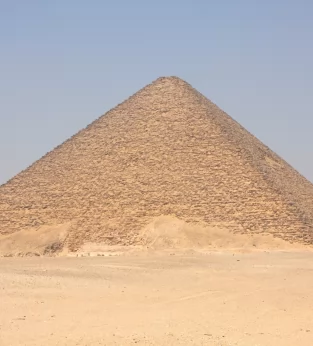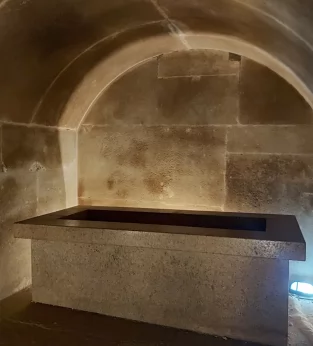Stay updated!
Tucked away in the serene desert landscape of Dahshur, the Bent Pyramid at Dahshur stands as one of Egypt's most fascinating and unique architectural wonders. Built around 2600 BCE during the reign of Pharaoh Sneferu, this distinctive structure marks a pivotal moment in ancient Egyptian engineering. Its sharp transition in angle, starting steep then softening midway, makes the Bent Pyramid instantly recognizable and an important link in the evolution of pyramid construction.
The Bent Pyramid's unusual shape offers rare insight into the early attempts to master the smooth-sided pyramid design. Unlike the later, more famous pyramids at Giza, this structure retains much of its original limestone casing, allowing visitors to see the craftsmanship in remarkable detail. Its well-preserved state and unique form provide a tangible connection to experimental architectural phase under Sneferu's ambitious vision.
Visiting the Bent Pyramid is a journey into a quieter, less crowded chapter of Egypt's ancient history. Surrounded by open desert and far from the bustling tourist hubs, the site offers a peaceful and immersive experience. Its relatively remote location ensures a more intimate encounter with the past, perfect for history enthusiasts and travelers seeking something beyond the well-trodden path.
Inside Egypt offers expert-led Bent Pyramid tours, granting access to one of the few pyramids that visitors can still enter. These guided experiences provide historical context, architectural analysis, and a deep appreciation for this often-overlooked masterpiece of ancient ingenuity.
Join us on a journey you'll never forget!
Photos of Dahshur’s Bent Pyramid
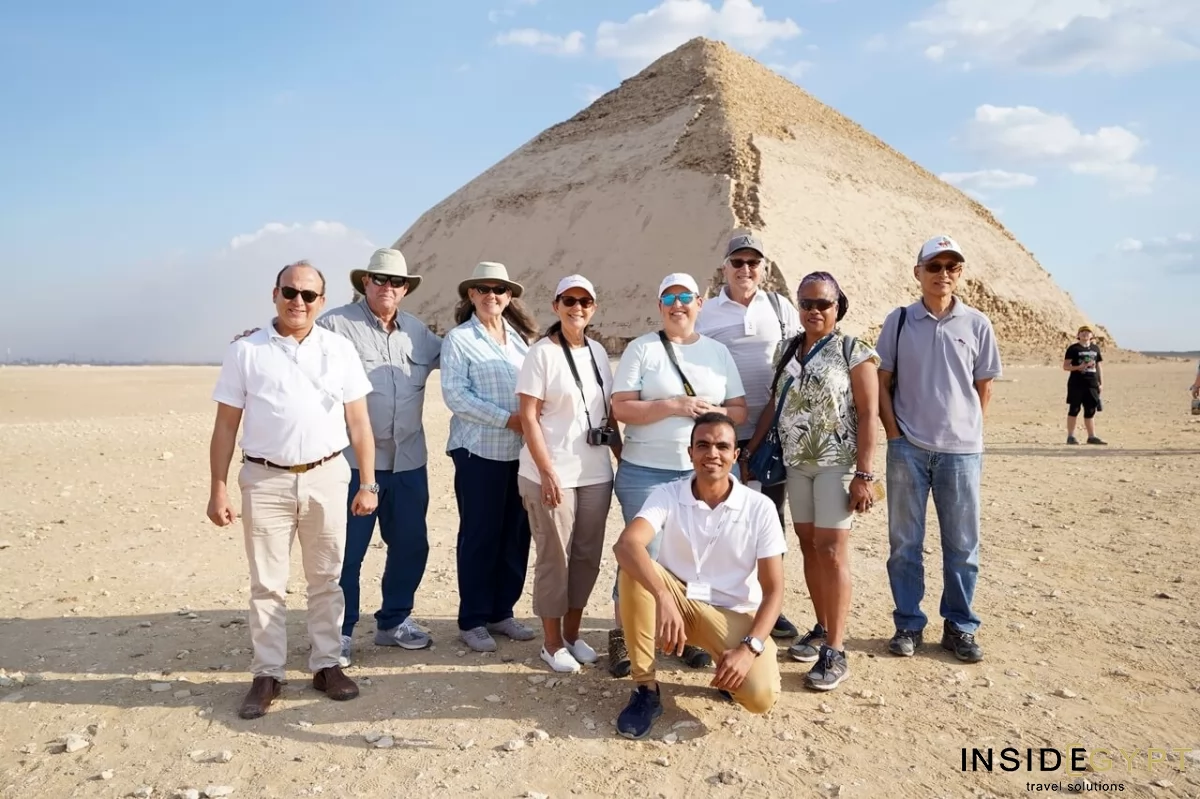
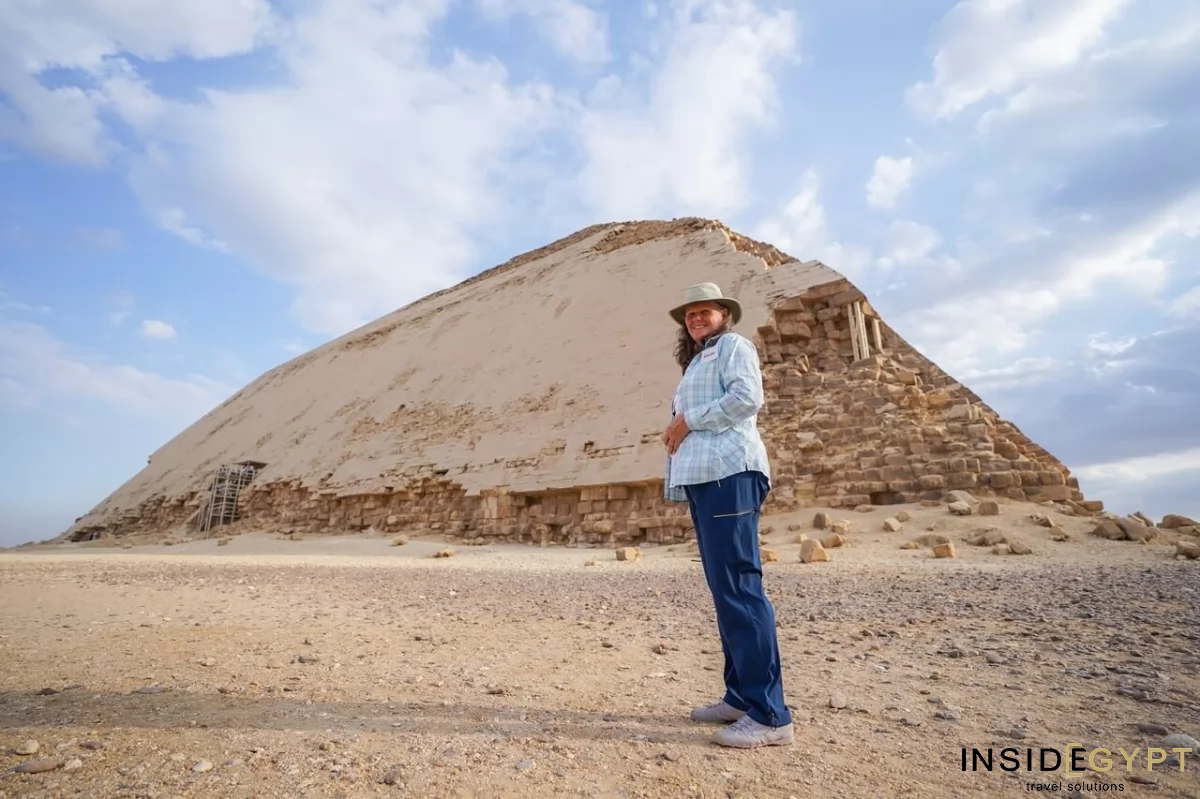
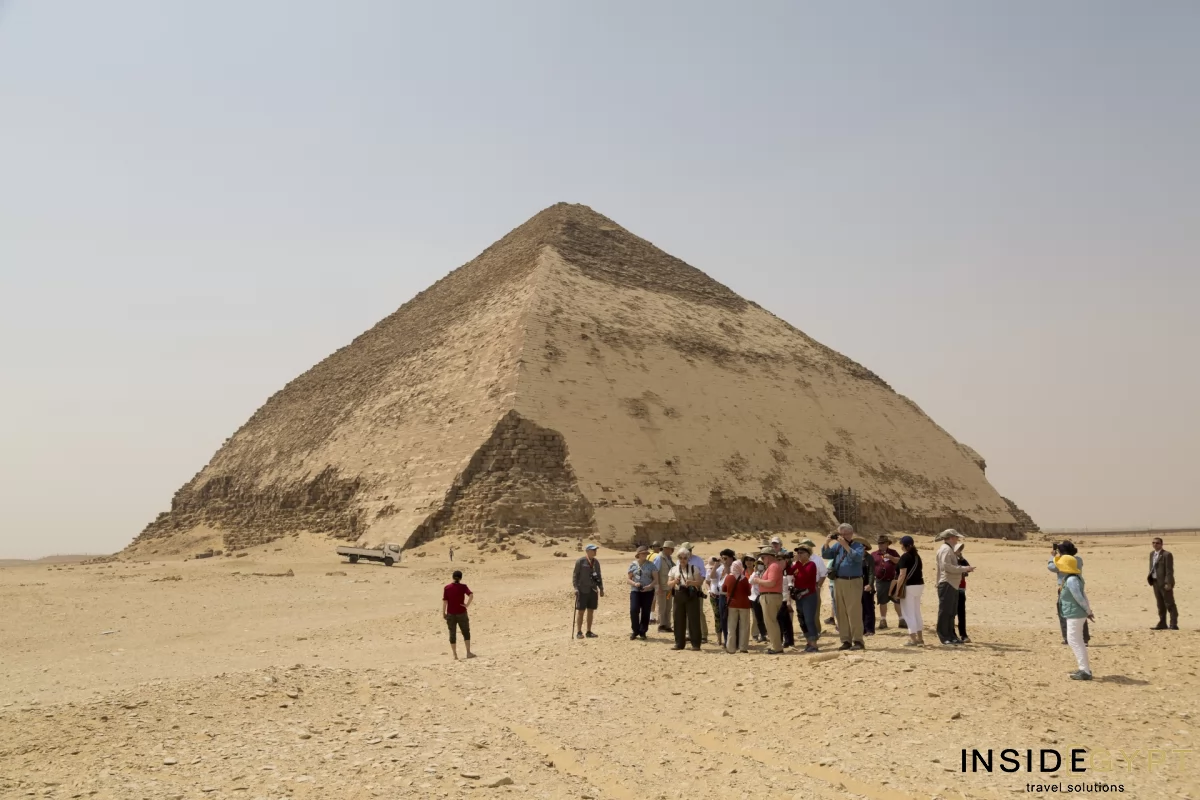
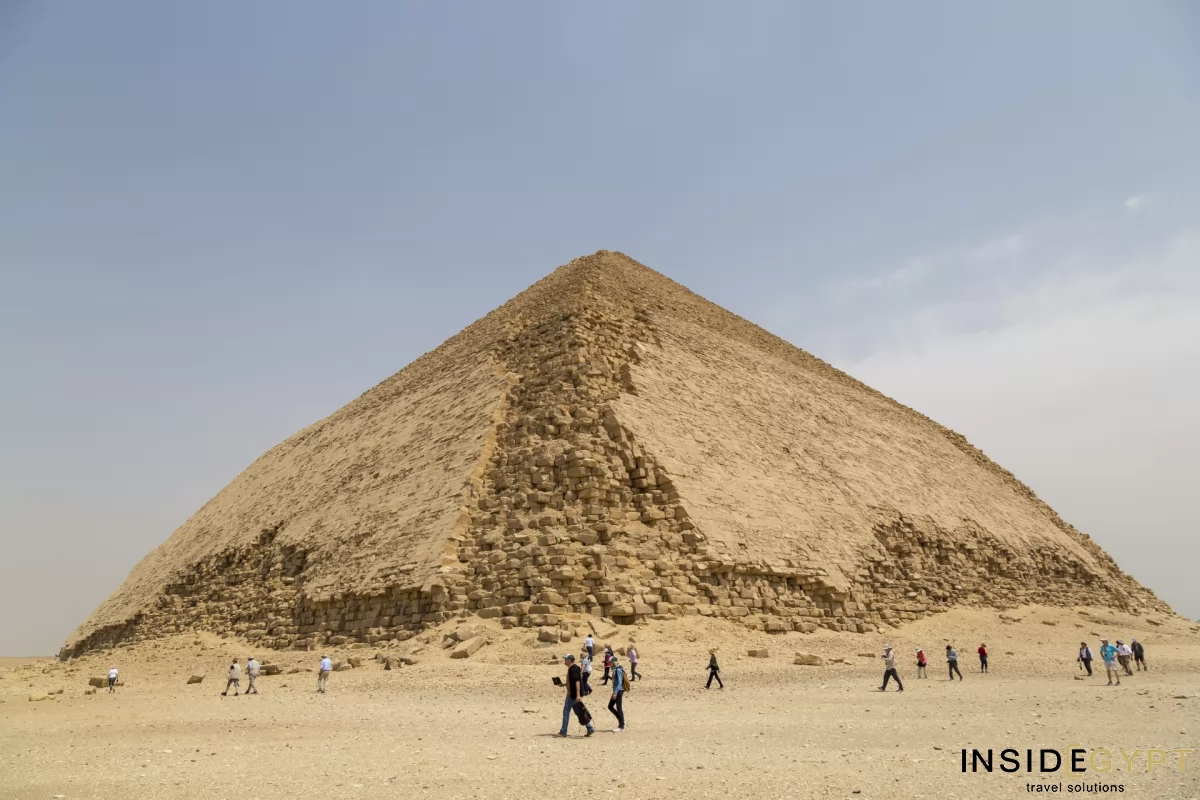
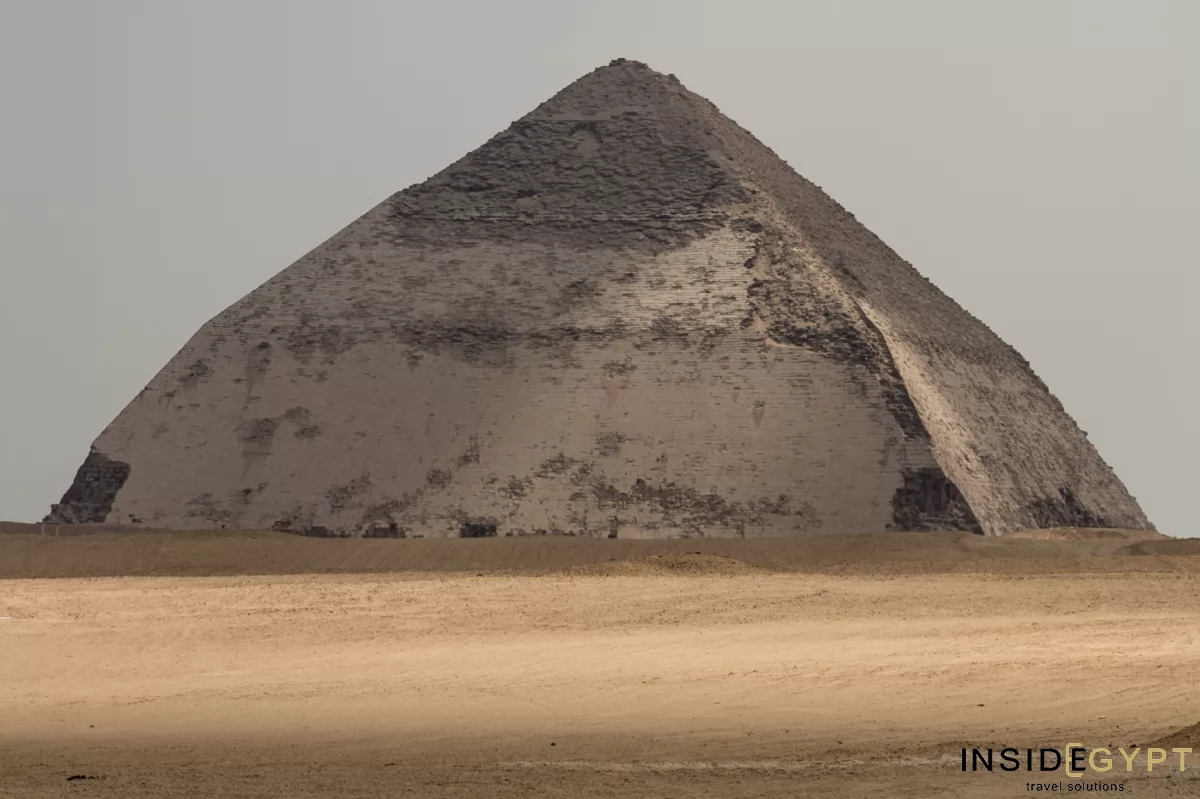
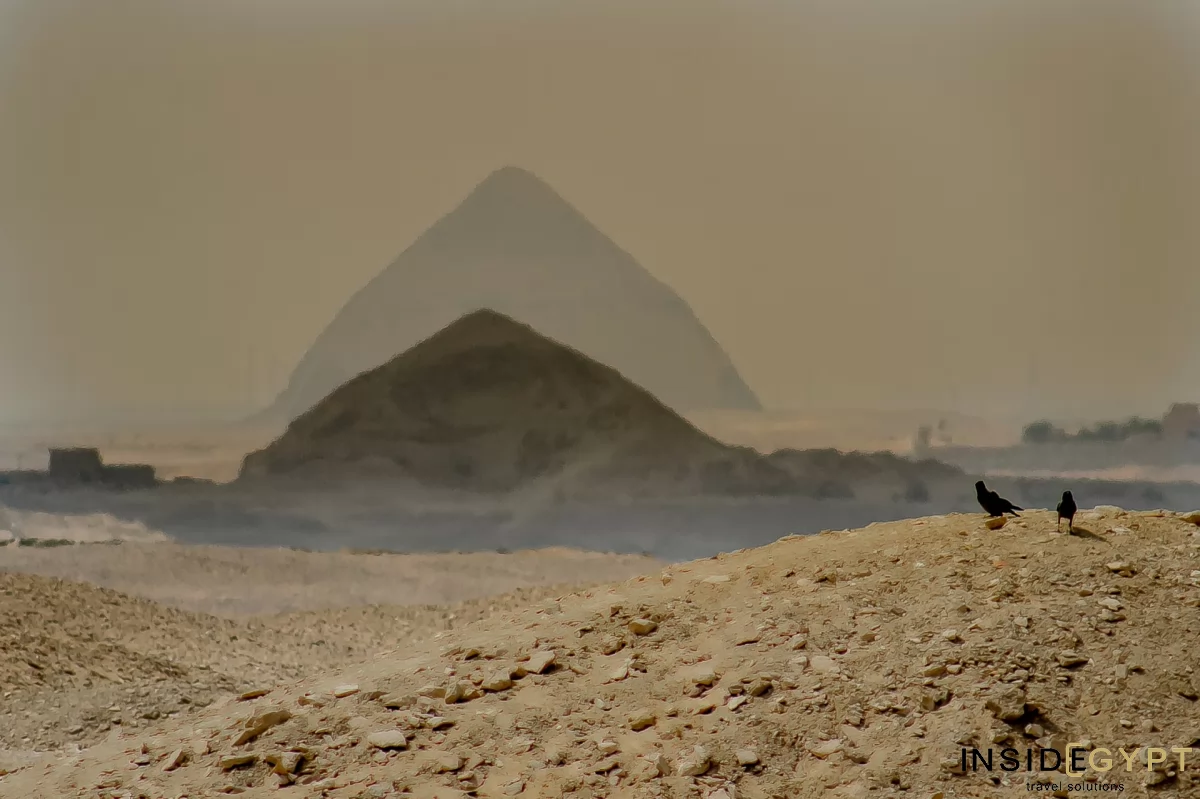

Discover Our Exclusive Egypt Tours
Tour Reviews
FAQs About the Bent Pyramid of Egypt
What is the Bent Pyramid?
The Bent Pyramid is one of Egypt's most remarkable and unusual ancient structures, often referred to as the crooked pyramid or curved pyramid due to its unique shape. Located in Dahshur and built by Pharaoh Sneferu around 2600 BCE, it represents a crucial transitional point in the evolution of pyramid construction.
One of the most recognizable facts about the Bent Pyramid is its double slope. The angle starts steep at 54 degrees near the base but abruptly shifts to a shallower 43 degrees partway up. This sudden change likely resulted from structural concerns during construction, making it a rare glimpse into the trial-and-error process of early Egyptian engineering.
Unlike the more familiar pyramids at Giza, the Bent Pyramid still retains much of its original polished limestone casing, offering insight into how these monuments originally looked. Its unique design and excellent preservation make it a standout example of early pyramid architecture.
So, what is the Bent Pyramid really? It's a masterpiece of experimentation, showing how ancient builders learned and adapted. Visiting this crooked pyramid offers a deeper appreciation for the ingenuity behind Egypt's iconic legacy.
Why and when was the Bent Pyramid built?
Why was the Bent Pyramid built? It was constructed as a royal tomb and architectural experiment during a key moment in ancient Egyptian history. Built under Pharaoh Sneferu in the 4th Dynasty, around 2600 BCE, the pyramid marked a major step in the evolution from step-sided to smooth-sided pyramid design.
When was the Bent Pyramid built? Its construction began early in Sneferu's reign, following his attempts with earlier pyramids at Meidum. The Bent Pyramid reflects an ambitious effort to create the first true smooth-sided pyramid. However, the steep original angle proved structurally unstable. Midway through construction, architects reduced the slope to about 43 degrees, resulting in the pyramid's distinctive "bent" shape.
This change in angle was likely a strategic decision to prevent collapse, making the pyramid a valuable lesson in architectural adaptation. As a result, the Bent Pyramid played a crucial role in informing the successful design of later pyramids, including the Red Pyramid, which was also built under Pharaoh Sneferu and is considered the first true smooth-sided pyramid.
The Bent Pyramid was both a royal monument and a revolutionary experiment, showing how early builders learned to master monumental stone architecture.
What’s inside the Bent Pyramid?
Inside the Bent Pyramid of Dahshur lies one of the most intriguing and well-preserved interiors of any ancient Egyptian pyramid. The Bent Pyramid contains two main chambers; one beneath the base and one higher within the structure, and these are connected by a series of steep, narrow passageways.
Visitors entering the Bent Pyramid of Dahshur descend through a low-ceilinged corridor into the lower chamber, notable for its high, corbelled roof designed to distribute weight and prevent collapse. A second passage leads upward to the upper chamber, which is also capped with a remarkable corbelled ceiling; an engineering solution showcasing early architectural ingenuity.
What sets this pyramid apart is that both chambers are located within the main body of the structure rather than beneath it, which was uncommon at the time. Also unique is the presence of an internal connecting shaft, possibly used for construction purposes or religious symbolism.
Today, the inside of the Bent Pyramid is open to the public, offering a rare opportunity to explore the inner layout of an ancient royal tomb. The experience is both physically demanding and unforgettable, as visitors walk the same corridors once intended for a pharaoh's eternal journey.
Where’s the Bent Pyramid located?
The Bent Pyramid location is in the Dahshur Necropolis, an ancient royal burial site about 40 kilometers south of Cairo. Situated in a peaceful desert setting away from the crowds of Giza, this pyramid offers a more serene and authentic experience for visitors exploring Egypt's rich architectural legacy.
Part of a larger area, the Bent Pyramid of Egypt stands alongside several other significant monuments, including the Red Pyramid; also built by Pharaoh Sneferu, and the later Black Pyramid of Amenemhat III. This grouping makes Dahshur a key site in the story of pyramid evolution, showing the transition from early experimentation to fully realized smooth-sided designs.
The surrounding area is quiet, expansive, and dotted with smaller tombs and ruins, providing a glimpse into the grandeur and complexity of ancient Egyptian necropolises. With fewer tourists than more famous locations, visitors can explore the site at their own pace, often with panoramic views of both pyramids and open desert stretching in every direction.
For those seeking to understand Egypt's architectural breakthroughs, the Bent Pyramid location is essential; offering history, innovation, and a sense of timeless wonder in one extraordinary site.
How can I visit the Bent Pyramid?
Visiting the Bent Pyramid is a remarkable journey into ancient architectural evolution. The site is best reached by private car or as part of an organized tour. The area is open daily from 8 AM to 4 PM, and both the Bent Pyramid and nearby Red Pyramid are open to the public. Adventurous travelers can even go inside the Bent Pyramid, navigating narrow passageways and steep ramps to explore its unique internal chambers.
Just a short distance away, the Red Pyramid also offers interior access and stunning views of the surrounding desert.
For the most enriching experience, we recommend visiting the Red Pyramid and the Bent Pyramid with a professional Egyptologist. Our expert-led Red Pyramid tour includes historical context, engineering insights, and personalized guidance that brings the ancient world to life. A guided visit ensures you don't miss important architectural features or hidden stories within these pioneering monuments.
Comfortable walking shoes, water, and sun protection are essential, as the site is open and exposed. With fewer crowds than Giza, Dahshur offers a peaceful and unforgettable glimpse into Egypt's royal legacy.
What are some interesting facts about the Bent Pyramid?
The Bent Pyramid at Dahshur is one of the most unusual and fascinating monuments in Egypt, full of quirks and historical intrigue. One of the most striking facts about the Bent Pyramid is its unique shape: the lower part rises at a steep 54-degree angle, but halfway up, the angle abruptly shifts to a gentler 43 degrees. This change gives the pyramid its "bent" look and has puzzled historians for centuries.
Many scholars believe the shape was not intentional but the result of structural issues, possibly cracks or instability that were detected during construction. To avoid collapse, builders reduced the angle to ease the pressure on the lower structure, making it one of the earliest architectural "corrections" in pyramid building.
Another surprising fact is that it is one of the few in Egypt that still retains a large portion of its original polished limestone casing, giving visitors a rare glimpse of how pyramids once gleamed in the sun.
Inside, two burial chambers lie at different levels, connected by narrow, corbelled passageways. A smaller satellite pyramid also sits nearby, believed to have had a ceremonial function. These elements together make the Bent Pyramid a captivating example of early royal experimentation and engineering genius.
Discover Our Exclusive Egypt Tours
Inside Egypt offers seven luxury small-group tours, expertly designed for travelers seeking authentic experiences, exclusive access, and deep cultural insight. Led by professional Egyptologists, most tours include a visit to the extraordinary Bent Pyramid in Dahshur — a rare architectural gem.
17-Day Long Nile Cruise from Cairo to Aswan
Cruise from Cairo to Aswan and back, with 14 nights on the Nile and visits to hidden gems like Abydos and Beni Hasan.
Bent Pyramid: ✅ Yes
15-Day Siwa Oasis Tour
Explore Cairo, Alexandria, Siwa, Abu Simbel, and Dahshur on this desert-meets-history adventure.
Bent Pyramid: ✅ Yes
14-Day Around Tour
See Cairo, Luxor, Aswan, Abu Simbel, Alexandria, and Dahshur, with VIP site access and a 7-night cruise.
Bent Pyramid: ✅ Yes
12-Day Red Sea Tour
Cultural exploration in Cairo, Luxor, and Dahshur, followed by beach time on the Red Sea.
Bent Pyramid: ✅ Yes
10-Day Exploring Egypt
Highlights of Dahshur, Giza, Luxor, and Aswan with a scenic Nile cruise.
Bent Pyramid: ✅ Yes
8-Day Golden Highlights Tour
Covers Giza and Luxor with a short cruise.
Bent Pyramid: ❌ No
7-Day Solar Eclipse Tour
Built around the 2027 eclipse in Luxor and top sites.
Bent Pyramid: ❌ No
Five of the seven tours include the Bent Pyramid, offering rare access to this ancient wonder.
What People Say About Our Bent Pyramid Tours
Visiting the Bent Pyramid is more than just a stop on a tour; it's a powerful experience that blends history, wonder, and expert storytelling. Our guests consistently describe this moment as a highlight of their journey through ancient Egypt.
"I had never even heard of the Bent Pyramid before this tour, but it turned out to be one of the most unforgettable places we visited. Standing in front of it, with almost no other tourists around, was surreal. Our Egyptologist guide explained the change in its angle and what it revealed about ancient construction techniques. It completely blew me away."
– Laura P., USA
"The Bent Pyramid at Dahshur felt like a secret treasure. It was quiet, untouched, and incredibly impressive. The guide's knowledge made the experience so much richer and I finally understood the 'why' behind the pyramid's unusual shape. I loved every second."
– Marcus V., Netherlands
"Inside Egypt's tour gave me access not just to places, but to their deeper stories. Walking into the Bent Pyramid's chambers while listening to our expert guide explain the engineering challenges Sneferu's builders faced was both moving and eye-opening."
– Nomsa K., South Africa
These authentic experiences reflect what makes our Bent Pyramid tours so special. Intimate access, expert insight, and lasting impressions that go far beyond the surface. Join us and see for yourself why this hidden gem continues to amaze our guests.


